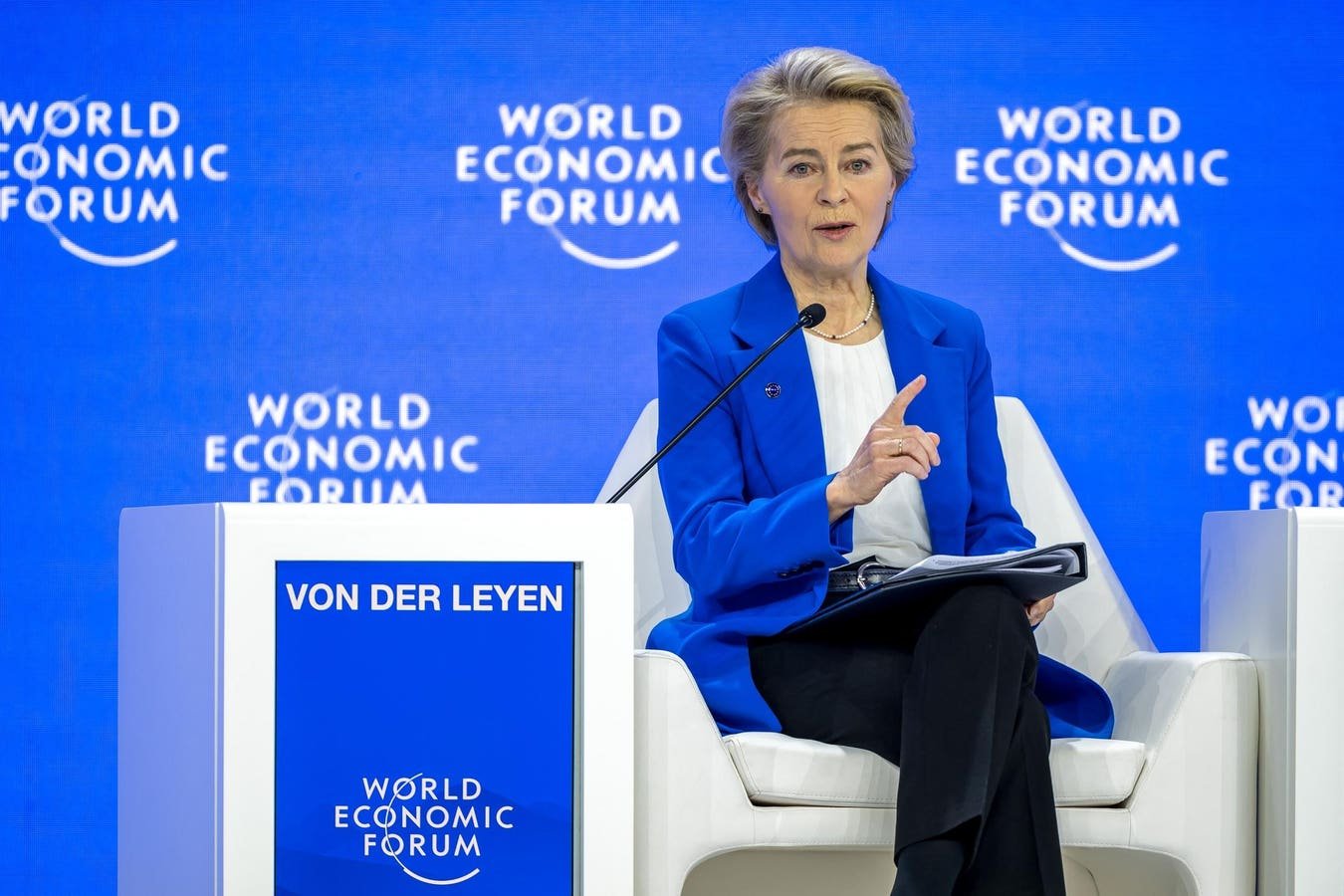European Commission President Ursula von der Leyen gestures during a session at the World Economic … [+] Forum (WEF) annual meeting in Davos on January 21, 2025. (Photo by FABRICE COFFRINI / AFP) (Photo by FABRICE COFFRINI/AFP via Getty Images)
Last week at the Davos meeting of the World Economic Forum, European Commission President Ursula von der Leyen launched the Global Energy Transition Forum in partnership with the Executive Director of the International Energy Agency, Fatih Birol. The GETF has three main objectives:
- To “sustain the momentum” toward achieving and strengthening the clean energy targets adopted in 2022 at the Dubai COP28 climate negotiations–most notably tripling the world’s renewable energy capacity and doubling the rate of energy efficiency improvements by 2030.
- To identify “flagship initiatives” that can translate these targets into concrete projects.
- To lower the cost of capital for clean energy investments.
No details have emerged since its unveiling, but the GETF appears to be an extension of the high-level dialogues the IEA organized before COP28 in Dubai and COP29 in Baku–with the support from the UAE, Azerbaijan, and the UN–to raise awareness and build consensus around actions needed to limit global warming to 1.5 degrees Celsius. The upcoming COP30 host, Brazil, will support the next round of energy transition discussions under the GETF framework.
The EU’s leadership in launching the GETF comes just after the U.S. withdrawal from the Paris Agreement, which President Donald Trump formalized two days before von der Leyen’s speech. It can be interpreted as a reaffirmation of the EU’s dual energy strategies: diversification and decarbonization, with a particular emphasis on reducing reliance on external suppliers. As a net energy importer, the EU has strong incentives to reduce fossil fuel imports and increase the share of renewables in its energy mix.
Pathways To Reducing Emissions
In a report released last September, the IEA outlined the “pathways to meet the COP28 outcome energy goals.” These include policies such as greater penetration of EVs and heat pumps, more reliance on public transportation, mandating stricter efficiency standards for appliances, retrofitting buildings, facilitating the permitting process to expand the coverage of electrical grids, and increasing electricity storage capacity. To curb emissions from fossil fuels, the IEA recommends phasing out fossil fuel subsidies and investing in equipment to reduce methane leakage, among other measures. The GETF should in principle serve to explore how to turn these proposals into reality.
At Davos, Birol highlighted that the world is on track to increase clean-energy investments 2.7 times, just short of the tripling required to meet the targets for 2030. Energy efficiency, in contrast, is advancing at a slower pace than required–2% instead of 4% per year. Fossil fuel demand, while expected to peak before 2030–a debated projection–, is not declining fast enough to align with the IEA’s net zero scenario for 2050.
Birol also pointed out that clean energy investments have doubled over the past decade, rising from $1 trillion to $2 trillion, but 85% of these investments have come from advanced economies and China. Emerging and developing countries, which make up 60% of the global population, account for the remaining 15%. He called this imbalance a key “faultline” in the energy transition, emphasizing the need for greater engagement from developing economies.
The Burden Of Transition Still Falls On Advanced Economies
Data from the Global Carbon Budget, available in Our World in Data, indicate that China and the U.S. alone account for 45% of global emissions. China emits twice as much carbon dioxide as the U.S., or 31% of the total. Along with the next eight major emitters–India, Russia, Japan, Iran, Saudi Arabia, Indonesia, Germany, and South Korea–, these countries account for close to 70% of global emissions. The remaining 30% comes from a vast majority of countries that individually contribute less than 2% of global emissions, with most emitting only negligible amounts.
This means that real progress in reducing carbon emissions still depends on the world’s largest economies–China, the U.S. and the EU–rather than smaller, more populated nations. However, the U.S. is now absent from the conversation, China is building more coal power plants, and some EU members have turned to coal power plants to address energy shortages.
Turning Talk Into Action
If the GETF is to make a difference in a world already inundated with energy dialogue initiatives, it must find a way to turn talk into action. Discussions on de-risking investments in the developing world and promoting clean energy projects will achieve little unless policies consistently make clean energy the more attractive option.
The world isn’t there yet: according to IMF researchers, fossil fuel subsidies reached $7 trillion in 2022–far exceeding the increase in clean energy investments. This figure includes direct production and consumption subsidies, forgone tax revenues, and implicit costs from air pollution, climate change, and road use.
There is hardly any mystery in this contrast between fossil fuel subsidies and clean energy investment. Consumers and producers of fossil fuels benefit from these subsidies, while politicians gain support by providing them. The GETF will likely succeed in raising awareness about options to change this policy trajectory, but its true test of usefulness lies in the realm of national politics.
